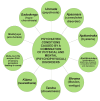Brain enhancing ingredients from Āyurvedic medicine: quintessential example of Bacopa monniera, a narrative review
- PMID: 23389306
- PMCID: PMC3635207
- DOI: 10.3390/nu5020478
Brain enhancing ingredients from Āyurvedic medicine: quintessential example of Bacopa monniera, a narrative review
Abstract
Āyurveda, the science (ved) of life (ayu), owing its origin to Veda, the oldest recorded wisdom of human civilization written in 3500 BCE, contains extensive knowledge of various diseases and their therapeutic approaches. It essentially relied on nature and the immune system of an individual, and therapeutic interventions were introduced only to augment the immune system. Āyurveda had eight specialties, including psycho-neuroscience (a combination of psychology, clinical psychology and psychiatry) and a unique promotive therapy encompassing nutrition, rejuvenation and geriatrics. The symptoms of various brain disorders, including memory disorder, were well defined. The goal of Āyurveda was to help an individual to achieve his cherished goal of leading a healthy life of 100 years. To achieve this, great emphasis was laid on nutrition, diet and a good conduct by the two great exponents of Āyurveda viz. Carak and Suśruta. By following these regimens, an individual could lead a less stressful life free from emotional disturbances. Both Carak and Suśruta had believed that these in combination with rasayana (rejuvenating) plants could enable an individual to lead a healthy life of 100 years.
Figures














Similar articles
-
Attenuation of 1-(m-chlorophenyl)-biguanide induced hippocampus-dependent memory impairment by a standardised extract of Bacopa monniera (BESEB CDRI-08).Neurochem Res. 2011 Nov;36(11):2136-44. doi: 10.1007/s11064-011-0538-7. Epub 2011 Jul 7. Neurochem Res. 2011. PMID: 21735137
-
Exploring the Role of “Brahmi” (Bacopa monnieri and Centella asiatica) in Brain Function and Therapy.Recent Pat Endocr Metab Immune Drug Discov. 2011 Jan;5(1):33-49. doi: 10.2174/187221411794351833. Recent Pat Endocr Metab Immune Drug Discov. 2011. PMID: 22074576 Review.
-
Scientific basis for the use of Indian ayurvedic medicinal plants in the treatment of neurodegenerative disorders: ashwagandha.Cent Nerv Syst Agents Med Chem. 2010 Sep 1;10(3):238-46. doi: 10.2174/1871524911006030238. Cent Nerv Syst Agents Med Chem. 2010. PMID: 20528765 Review.
-
The Ayurvedic plant Bacopa monnieri inhibits inflammatory pathways in the brain.J Ethnopharmacol. 2017 Feb 2;197:92-100. doi: 10.1016/j.jep.2016.07.073. Epub 2016 Jul 26. J Ethnopharmacol. 2017. PMID: 27473605 Free PMC article.
-
Investigating neuroprotective roles of Bacopa monnieri extracts: Mechanistic insights and therapeutic implications.Biomed Pharmacother. 2022 Sep;153:113469. doi: 10.1016/j.biopha.2022.113469. Epub 2022 Jul 31. Biomed Pharmacother. 2022. PMID: 36076495
Cited by
-
Herbal drugs and natural bioactive products as potential therapeutics: A review on pro-cognitives and brain boosters perspectives.Saudi Pharm J. 2021 Aug;29(8):879-907. doi: 10.1016/j.jsps.2021.07.003. Epub 2021 Jul 15. Saudi Pharm J. 2021. PMID: 34408548 Free PMC article. Review.
-
Development of optimal medium content for bioelements accumulation in Bacopa monnieri (L.) in vitro culture.Appl Biochem Biotechnol. 2014 Oct;174(4):1535-1547. doi: 10.1007/s12010-014-1095-8. Epub 2014 Aug 15. Appl Biochem Biotechnol. 2014. PMID: 25119546 Free PMC article.
-
Bacopa monniera (CDRI-08) Upregulates the Expression of Neuronal and Glial Plasticity Markers in the Brain of Scopolamine Induced Amnesic Mice.Evid Based Complement Alternat Med. 2015;2015:837012. doi: 10.1155/2015/837012. Epub 2015 Aug 27. Evid Based Complement Alternat Med. 2015. PMID: 26413129 Free PMC article.
-
Vasodilatory Effects and Mechanisms of Action of Bacopa monnieri Active Compounds on Rat Mesenteric Arteries.Molecules. 2019 Jun 15;24(12):2243. doi: 10.3390/molecules24122243. Molecules. 2019. PMID: 31208086 Free PMC article.
-
Regenerative medicine in Alzheimer's disease.Transl Res. 2014 Apr;163(4):432-8. doi: 10.1016/j.trsl.2013.11.001. Epub 2013 Nov 8. Transl Res. 2014. PMID: 24286919 Free PMC article. Review.
References
-
- Sheth S. Religion and Society in Brahma-Purana. Sterling; New Delhi, India: 1979. pp. 251–252.
-
- Schwartz S. Psychoactive Herbs in Veterinary Behavioral Medicine. Blackwell Publishing; Oxford, UK: 2005. p. 70.
-
- Tewari S.P. Royal Attendants in Ancient Indian Literature: Epigraphy & Art. Agam Kala Prakashan; Delhi, India: 1987. p. 117.
-
- Rao R.S.K. Encyclopaedia of Indian Medicine: Historical Perspective. Popular Prakashan; Bombay, India: 2005. p. 106.
-
- Das A.C. Rigvedic India. Motilal Banarasi Das; Mumbai, India: 1971. p. 85.
Publication types
MeSH terms
Substances
LinkOut - more resources
Full Text Sources
Other Literature Sources

